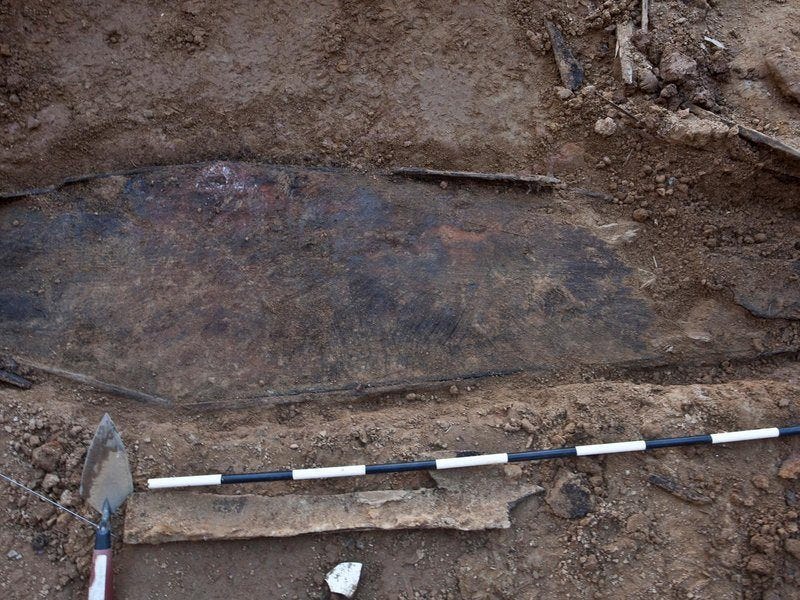PHILADELPHIA OLD CITY'S FORGOTTEN DEAD
In February 2017, Philadelphia crews working on an apartment building in the city's historic district got a shock when their backhoes started hitting coffins and unearthing fully intact human remains.

The site was supposed to be a former burial ground from 1707, and all the remains were supposedly exhumed in the 1800s and moved to a different cemetery, which apparently they weren't.
Crews found dozens of coffins in a former parking lot near 2nd and Arch Streets in Old City, Philadelphia. The discovery brought construction of a new apartment complex project to a halt.
The site was a former cemetery for the First Baptist Church of Philadelphia (FBCP). Begun in 1698, as a mission of the more suburban Pennepack (now, Lower Dublin) Baptist Church, the congregants met at an old Quaker meeting house for services. The church soon became the leading congregation for the city, region, and colonies. A cemetery was established on the south side of Arch Street starting in 1707 until 1860.
In 1855, the congregation moved to a new building at Broad and Arch Streets. According to church records, the remains were said to be exhumed and re-interred at Mount Moriah Cemetery, which is north of the city around 1860. Historians agree that someone didn’t do their job.
“It’s a business unfortunately and sometimes it’s cheaper to cut corners in a business,” Dr. Lee Arnold with the Historical Society of Pennsylvania said.
The newfound remains, those of both children and adults, are in addition to some first discovered here by a PMC Property Group contractor in November 2016. Since the discovery, around 60 human remains have been unearthed, many of them intact inside their coffins. Even though the site is presently cleared, different buildings have sat on this location throughout the years.
Kimberlee Moran, an associate teaching professor and director of forensics center at Rutgers University said:
We’ll try to find out anything that these bones can tell us about who these people were in life. This is a rare opportunity to learn as much as we can about the earliest residents of Philadelphia. Ultimately, we want to reinter them at Mount Moriah Cemetery with the rest of the remains from this time period. If there are any living descendants, we are going to try to identify them.
A church record in 1870, after the move date, showed a membership of about 500, so we thought we’d be dealing with a small number of burials, but from City death records and newspaper accounts, there were about 1,700 named individuals. If you included the unnamed, it totaled around 3,000.The area where the church had been had the most dense number of burials. It’s now under a structure, but there are definitely remains under it. There are headstones memorializing folks from FBCP in Mount Moriah, but whether they’re actually under there isn’t clear. Old headstones were also used as walkways in the plot.
The coffins were far below the standard six feet we know today, but this could be accounted for due to layers of road and flooring added throughout the year. Some were found as deep as 15 feet.
Approximately 500 individuals were unearthed, and it's believed that another 600 to 800 burials were destroyed during the excavation.
According to cemetery records, the church hired a contractor to move the coffins and hand dig new graves at Mount Moriah in the coldest months of the year when the ground was frozen over. This made a difficult project, back-breaking to say the least, which could account why so many graves were left behind.

On the edge of Philadelphia, Mount Moriah cemetery sprawls over 380 acres, spreading into Delaware County and sheltering 80,000 thousand graves. Located at Kingsessing Avenue and 62nd Street, it is the resting place of Civil War soldiers, and former Philadelphia mayor Samuel Miles interred in 1805. He was an American Revolutionary War general and statesman. The founder of Brown University is also buried here.
In April 2011, the cemetery was abandoned and the Friends of Mount Moriah Cemetery, incorporated in 1855, began working to restore the property, which had been neglected for many years, leaving it to become an illegal dump site.
For five years after the discovery at 219 Arch Street, the Arch Street Project which has undertaken to recover, study and rebury all the remains in September, 2023 at Mt. Moriah Cemetery, has documented the histories of the persons buried there.
But not all the bones of those FBCP congregants have been discovered. A mystery persists as to where the actual remains are interred at. Some are possibly at Mt. Moriah in section 112, others could be part of the bones being studied by the Arch Project, others could be part of a group deposited in a landfill by developers in 2016, or left behind in their original location on Arch Street, presently under a multi-floor, modern building.
In August, 2024 another old Philadelphia cemetery with 33,000 burials went up for sale for $1 million.
Mount Vernon Cemetery sits on 26 acres in northeast Philadelphia. It opened in 1856 and the last burial took place in 1968. Sadly there are no accurate maps or records of the burials. There are many historical people buried there including the Drew and Barrymore acting families.
Louisa Drew married actor John Drew in 1850, and was the mother of Louisa, John, Jr., and Georgiana Drew, as well as the grandmother of Lionel, Ethel, and John Barrymore, all actors. She managed the Arch Street Theatre in Philadelphia for 31 years.
Up to 2021 it was owned by Joseph Dinsmore Murphy who let it fall into complete disrepair and become overgrown.







